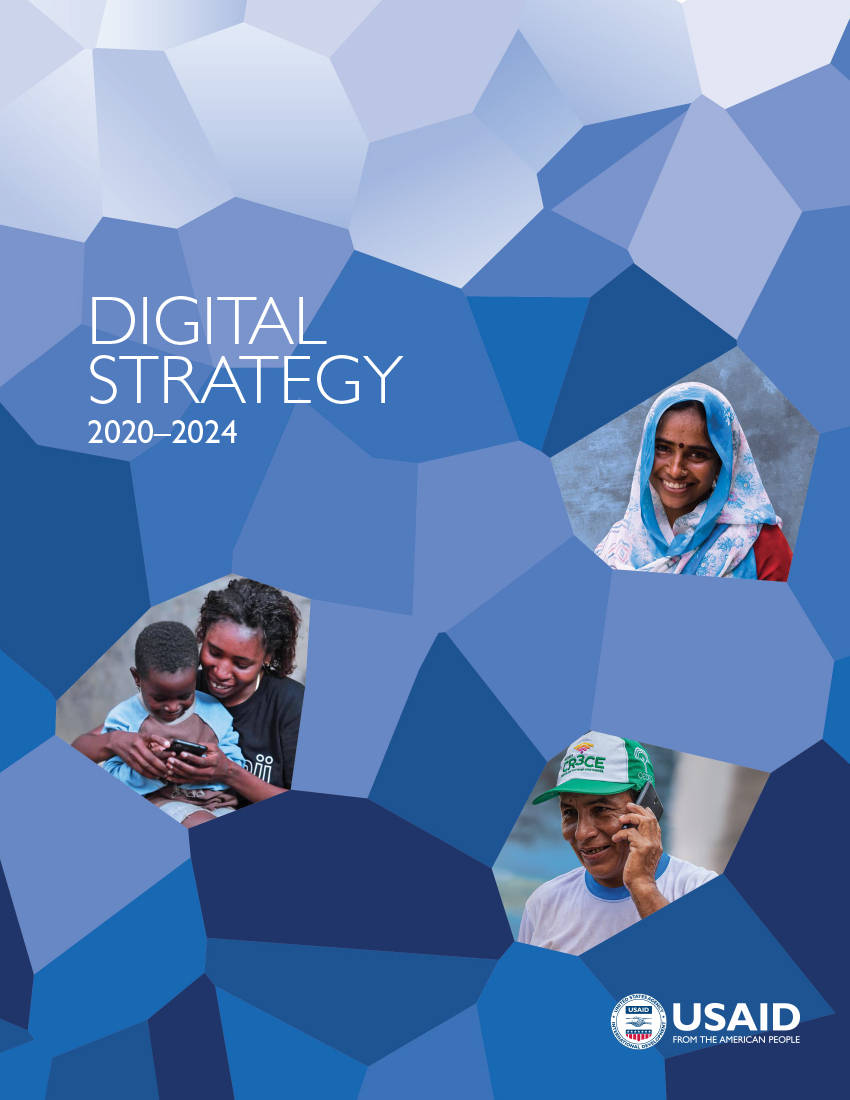- What We Do
- Agriculture and Food Security
- Democracy, Human Rights and Governance
- Economic Growth and Trade
- Education
- Environment and Global Climate Change
- Gender Equality and Women's Empowerment
- Global Health
- Humanitarian Assistance
- Transformation at USAID
- Water and Sanitation
- Working in Crises and Conflict
- U.S. Global Development Lab
Digital Strategy
Speeches Shim
The vision of USAID’s Digital Strategy is to advance progress in communities in our partner countries on their Journeys to Self-Reliance through efficient, effective, and responsible digital initiatives that enhance security and economic prosperity, consistent with the American values of respect for individual rights, freedom of expression, and the promotion of democratic norms and practices.
USAID will work toward two mutually reinforcing strategic objectives:
- Improve measurable development and humanitarian-assistance outcomes through the responsible use of digital technology in our programming; and
- Strengthen the openness, inclusiveness,c and security of country digital ecosystems.
The strategic use of digital technology in USAID’s programming not only should help us achieve our development and humanitarian-assistance outcomes but also strengthen the critical components of the digital ecosystem that help us achieve our own goals and empower all individuals to achieve their own aspirations. USAID’s digital interventions must go beyond the activity level and, when possible, address the systemic gaps and market failures in digital technology that make the need for donor interventions a persistent reality.
The Digital Strategy supports the 2018-2022 State-USAID Joint Strategic Plan that calls on the U.S. Department of State and USAID to “[t]ransition nations from assistance recipients to enduring diplomatic, economic, and security partners” (Strategic Objective 3.1).8 As USAID looks forward to the day when foreign assistance is no longer necessary, we must understand the potential for digital technology to accelerate or undermine the Journey to Self-Reliance.
TWO MUTUALLY REINFORCING OBJECTIVES
Strong digital ecosystems enable better development programming across sectors, which, in turn, can drive improvements in digital ecosystems. For example, in the Kingdom of Cambodia, USAID’s Development Innovations project helped connect civil society and the technology community to design and use digital solutions to address development challenges. These tech-enabled solutions reached 1.6 million Cambodians and improved government accountability; the protection of natural resources; education; health care; and the preparedness for, and response to, disasters. The project cultivated a diverse community of Cambodian innovators who can design and build technology products to address their own development challenges. By focusing not only on the digital solutions but also on advancing opportunities in technology and entrepreneurship for local innovators, youth, and women, the project has built a pipeline of small businesses that will continue to strengthen and shape Cambodia’s digital ecosystem.7

THE DIGITAL JOURNEY TO SELF-RELIANCE
A country’s commitment and capacity to respond to the unique opportunities and challenges posed by the digital age depends upon the ability to become self-reliant. In alignment with existing U.S. policies and frameworks,9 and in cooperation with the U.S. Government interagency, USAID plays an integral role in supporting governments, civil society, the private sector, and local communities along their digital Journeys to Self-Reliance.
USAID must help to strengthen the security and resilience of digital ecosystems in our partner countries, which increasingly will serve as the foundation of open, accountable, and citizen-responsive governance; inclusive development; and economic growth. USAID must provide opportunities to train the workforce of tomorrow in our partner countries and build digital literacy among individuals in the developing world.
USAID recognizes that fostering self-reliance in the digital age means working with all actors in a local system, which includes foreign firms and non-governmental organizations (NGOs). Additionally, fostering self-reliance in digital ecosystems means building productive linkages that reach beyond national borders. These cross-border linkages can strengthen the local environment for self-reliance by speeding and spreading innovation; creating access to new markets via digital platforms; and fostering a more secure, trustworthy online environment. Indeed, digital issues often transcend national boundaries. Digital businesses operate in international markets; cyber threats cross borders with ease; and nations depend on a global network of fiber-optic cables. Each country’s Journey to Self-Reliance is linked to a digital ecosystem that is part of a regional or global whole and will benefit from an open, interoperable, secure, and reliable cyberspace.
THE DIGITAL JOURNEY TO SELF-RELIANCE
The following are examples of how digital technology can promote self-reliance:
OPEN AND ACCOUNTABLE GOVERNANCE
In Ukraine, the pilot of the USAID-supported e-procurement platform, ProZorro, helped the national government cut costs by 12 percent (which amounted to $1.4 billion by 2018).10 Perceived corruption decreased from 59 percent to 29 percent from 2016-2017, and the percentage of suppliers who are small and medium-sized enterprises (SMEs) went from 24 percent to 80 percent from 2015 to 2018.11
INCLUSIVE DEVELOPMENT
- 74% of women in low- and middle-income countries say that having a mobile phone saves them time
- 60% say it saves them money
- 68% of women report feeling safer with a mobile phone
- 58% feel more independent12
ECONOMIC POLICY
In the Republic of the Philippines, USAID supported the digital transformation of tax administration, which increased e-filing rates from less than eight percent in 2013 to nearly 80 percent in 2019. This assistance helped the Government of the Philippines generate $3.5 billion in additional tax revenues in 2018.
ADVANCING U.S. NATIONAL SECURITY AND ECONOMIC PROSPERITY
DIGITAL CONNECTIVITY AND CYBERSECURITY PARTNERSHIP (DCCP)
In support of the U.S. Government’s cybersecurity priorities, Secretary of State Mike Pompeo launched the DCCP in July 2018, a whole-of-Government initiative to promote access to an open, interoperable, reliable, and secure Internet to counter authoritarian influences on communications infrastructure. The DCCP Interagency Working Group, which USAID and the U.S. Department of State co-chair, supports the development of open communications infrastructure through private-sector engagement; promotes transparent regulatory policies for free, competitive markets; and builds partners’ cybersecurity capacities to address shared threats. DCCP will help the governments and the private sector in our partner countries realize the tremendous economic and social benefits of the digital economy, while creating new commercial opportunities for U.S. and local technology companies.
As stated in the U.S. National Security Strategy, “America’s response to the challenges and opportunities of the cyber era will determine our future prosperity and security.”18 While the economy of the United States becomes increasingly dependent on digital technology, and as Americans rely more heavily on a secure cyberspace, investments in the development of robust, resilient, and secure digital economies become even more crucial to our national security and economic prosperity. Thus, one of the pillars of the U.S. National Cyber Strategy is to “promote an open, interoperable, reliable, and secure internet,” and to build the cyber capacity of our allies and partners.19
The USAID Digital Strategy will help the Agency advance U.S. national security and economic prosperity. In support of the U.S. Government’s goals to advance our national security and economic prosperity, USAID will work with governments and the private sector in the countries where we work to promote informed investments in the development of communications infrastructure and digital markets, because networks intrinsically present greater cybersecurity and supply-chain risks as they increase in scale. This is especially urgent as countries increase their Internet connectivity by shifting from 3G and 4G (third-/fourth-generation) to 5G (fifth-generation) communications networks.20 Authoritarian governments’ subsidies to their national champions or state-owned enterprises allows these firms to offer fiber-optic networks and network equipment, including technology used to monitor populations on a mass scale and to restrict citizens’ access to information, on (often deceptively) favorable financial terms. Such malign practices enable authoritarian regimes to dominate the telecommunications industry and control digital tools that can increase censorship and repression—to the disadvantage of the United States, our allies, and our values, which include democracy, market economy, inclusion, rights, freedom, and accountability.
c. Access, affordability, and adoption are the three principle drivers of digital inclusion. Inclusive digital ecosystems describe systems in which digital infrastructure, technology, and services are not only equally accessible and available to everyone, but that are also affordable to all members of society and designed to account for the cultural, contextual, and other barriers (e.g., gender, language, disabilities, education, etc.) that must be overcome in order to become a regular user of the Internet.
THE FOLLOWING ARE EXAMPLES OF HOW DIGITAL TECHNOLOGY CAN PROMOTE SELF-RELIANCE
GOVERNMENT CAPACITY
The Better Than Cash Alliance reports that the Mexican Government saves $1.27 billion each year through the use of digital payments.13
CITIZEN CAPACITY
Thanks to digital tools like mobile money, communities have greater access to financial services and are more stable and self-reliant. In the Republic of Kenya, the mobile-money system M-PESA has lifted 194,000 households, or two percent of Kenyan households, out of poverty.14
CAPACITY OF THE ECONOMY
By increasing the adoption of mobile phones and fully enabling digital financial services, the Gross Domestic Product (GDP) of emerging economies could increase by more than $3.5 trillion, or six percent, by 2025.15 E-commerce could increase international trade by up to $2.1 trillion by 2030.16
CIVIL SOCIETY CAPACITY
Digital technology enables civil society to hold government and service delivery-providers accountable. Following the highly contested 2014 presidential election in the Republic of Indonesia, a group of volunteers quickly built a website and digitized voting tabulations, many of them handwritten, to enable better monitoring and tracking of the election results and address accusations of vote rigging.17



Comment
Make a general inquiry or suggest an improvement.